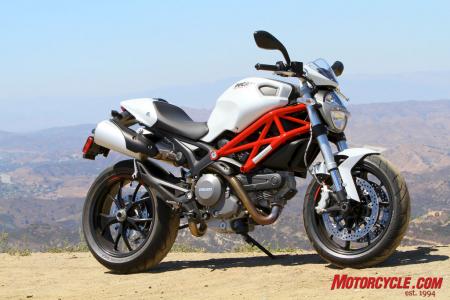 |
| Top Ducati Monster 796 Review |
The 2011 Monster 796 expands Ducati’s Monster line to three base models, and fits perfectly between the smaller and larger displaced 696 and 1100 Monsters. |
Nearly two years have passed since the 1100 hit the streets. Would the Monster lineup consist of only two models?
Middle child born out of order
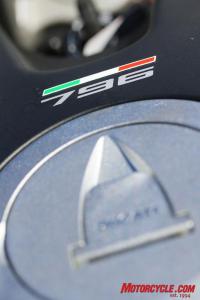 |
| Top Ducati Monster 796 Review |
The 796 designation belies the Monster 796’s 803cc displacement.
It started to seem two new Monsters is all we’d get, as Ducati pumped out other non-Monster models posthaste on the heels of the Monster 1100 introduction. Three new motorcycles (the 1198 superbike, the Streetfighter and the Hypermotard 796) were unveiled over a yearlong period, from late 2008 to late 2009, yet not one of them would grow the new Monster line.However, as in life, and for reasons we don’t always understand, things arrive seemingly out of order.
It wasn’t until April of this year Ducati let the monster out of the bag that a third naked sportster would join the Monster family. Rather than move up the performance ladder, surpassing the Monster 1100, the latest M bike, the Monster 796, slots right in the middle.
Ducati did the mash. They did the Monster mash.
The 796 fits the “monster” moniker well; it’s an amalgam of naked Ducatis.
The same air-cooled, two-valver, 803cc L-Twin lump that motivates the Hypermotard 796 powers the Monster 796, while its single-sided swingarm and wheels are the same as those on the Monster 1100. The 796’s wheels are spruced up with partial red pinstripe, and spin the same 180/55 rear and 120/70 front Pirelli Diablo Rosso tires fitted to the 1100.
The meaty steel-tube trellis main frame is shared across the Monster line, but the 796 employs a new subframe to allow for accessory bolt-on passenger grab handles.
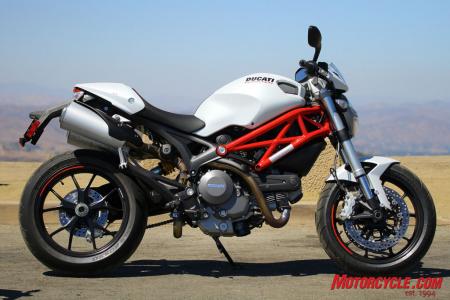 |
| Top Ducati Monster 796 Review |
Chunky but artful looking steel-tube trellis main frame is shared across the Monster line. The 796 gets the Monster 1100’s wheels, swingarm and tires.
Suspension on the 796 consists of an inverted, non-adjustable 43mm Showa fork and a Sachs shock adjustable for spring preload and rebound damping – similar to that on the Monster 696. The Monster 1100’s 43mm inverted Showa fork is fully adjustable while its Sachs shock offers the same range of adjustments found on the 696 and 796.Scrubbing speed on the 796 is the work of dual four-piston radial-mount Brembo calipers grabbing 320mm discs; a two-pot Brembo squeezes a 245mm disc out back. This is essentially the same system utilized on the 696 and 1100, save for the use of a radial-pump master cylinder on the biggest Monster.
Standard niceties for the middle child Monster include an attractive “micro bikini” windscreen, four-way adjustable clutch and brake levers and a pillion seat cover.
Press materials for the 796 eagerly highlight its 31.5-inch seat height is 0.4 inch lower than the 1100’s saddle, and that the 796’s tapered handlebar sits 0.8-inch higher than the bigger Monster’s bar. These changes, says Ducati, are made in response to Monster customers’ requests. In fairness to the 696 we figured we’d let you know its seat is 30.3 inches off the ground.
“Micro-bikini” fairing comes standard. One-piece tubular handlebar is a little less than an inch higher than the Monster 1100’s bar. The headlight is identical to headlights on the 696 and 1100. |
Ducati claims the new Monster 796 weighs 369 lbs dry, while the 696 scales in with 355 lbs dry and the 1100 bellies up to the bar with 373 lbs dry. Optional ABS (available for all Monsters as of 2010) adds about four pounds and $1,000 to each model; ABS also reduces the standard Monsters’ 3.8-gallon fuel capacity by 0.2-gallons.
Splitting the difference in Monster performance
The 796 strikes the perfect balance in the Monster lineup.
During our dyno testing the 796’s 803cc Twin produced 76.1 peak rwhp at 8400 rpm – only a few hundred rpm short of redline – with peak torque just shy of 53 ft-lbs at 6400 rpm.
Those figures likely won’t thrill literbike fans, but the 796’s additional 107cc bring a nice improvement in thrust over the 696’s somewhat wheezy mill (80 hp and 50.6 ft-lbs claimed at the crank). Of course, the middle Monster’s engine isn’t as exhilarating as the 1100’s more potent lump that churned out 85 ponies and 68.5 ft-lbs for us early last year.
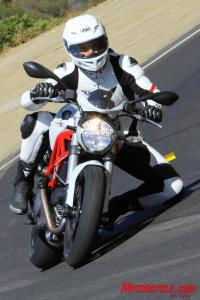 |
| Top Ducati Monster 796 Review |
Editor Jeff Cobb easily plants a knee while strafing canyons aboard the new Monster 796. He found that although the footpegs touch down now and then, “they are high enough that you’re a hero if you do it regularly.”
However, the 796’s predictable power production makes for a more manageable ride – an appealing quality for newer or returning riders – compared to the sometimes-a-handful amounts of low-end torque the 1100’s bigger, 1078cc Twin is capable of making.Common to most Ducs is snatchy low-rpm fueling; the Monster 796 is no less a victim of this known issue. Get the 796’s digital bar graph tach registering above 4K rpm, or so, and it’s smooth sailing throttle response from there on out.
Middle child Monster retains the light but neutral handling, and excellent mid-corner stability, the other two Monsters provide. Brake performance from the 796’s Brembos consists of lots of stopping force – impressive force, actually! Braided stainless steel lines offer good feedback allowing the rider to easily and accurately modulate stopping power at the lever.
The clutch system also uses a stainless steel line, which is at least partly responsible for a remarkably low-effort pull at the lever. Unfortunately, this easy lever action hightpoint is all but negated by an ultra-sticky six-speed gearbox. Shifting was decent once up to speed, but low rpm shifts were notchy, and finding neutral was nothing less than a mechanical annoyance.
Since our Monster 796 was a virtual FOB (fresh off the boat) test unit with hardly any miles on the all-digital clock, out of pity we gave the trans a passing grade rather than flunking it altogether.
Crazy tall gearing is also a nominal but notable drawback for the transmission. An enterprising and creative 796 owner could fiddle with different countershaft or rear sprocket changes to help the bike accelerate more briskly up top, and overcome the tall gearing that’s likely a result of ever-stricter emissions regulations.
Radial-mount Brembo calipers mercilessly squeeze 320mm rotors, offering more than enough stopping power. Our 796 test unit was ABS-equipped. We could feel ABS activation in the brake lever, but pressure feedback was far less intrusive than on other modern ABS systems we’ve sampled. Pirelli’s Diablo Rosso tire is a perfect match to the 796’s overall performance package. |
During our time with the 796 we saw an observed 40 mpg. The 796 should easily eclipse our measured fuel economy if you factor out fuel-eating repetitive photo passes and our immature activity of wheelie-ing from stoplights whenever possible.
Middle Monster the best Monster?
Regular Motorcycle.com guest tester, and owner and rider of many Ducatis, Kaming Ko, proclaimed the Monster 796 as the best of three Monsters. This is an interesting opinion considering Kaming is a salty vet rider fond of large displacement sportbikes.
Kaming lauded the 796 for its welcoming, confidence-inspiring neutral handling that’s complemented by just enough get up and go power from the engine to make riding the 796 all day long fun.
Distinctly Ducati, distinctly a Monster. Pound for pound, the 796 might be the best of combination of all things that make a Monster. |
Indeed, the M-796’s combination of handling, excellent brake performance and an engine that’s plenty powerful yet easily managed, make this Monster the perfect combo of its Monster mates.
In nearly every way, including pricing, the 796 goes right up the middle. An MSRP of $9,995 is $1,000 more than the Monster 696 and $2,000 less than the Monster 1100.

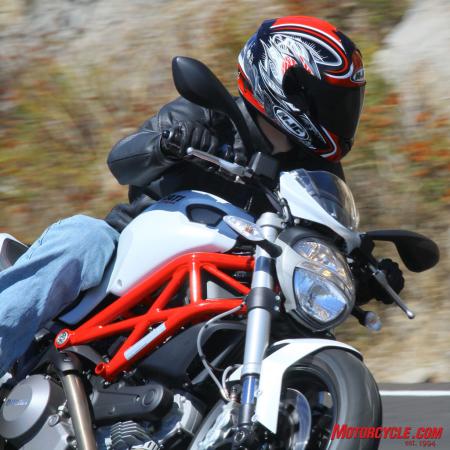
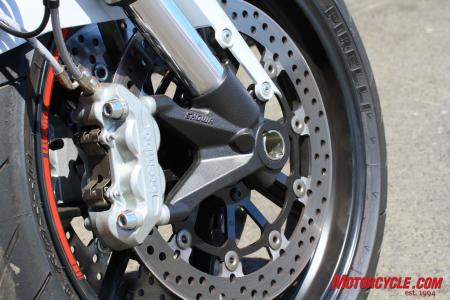
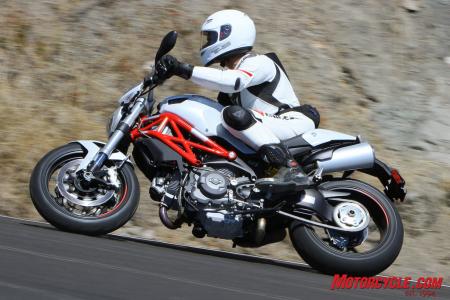
No comments:
Post a Comment